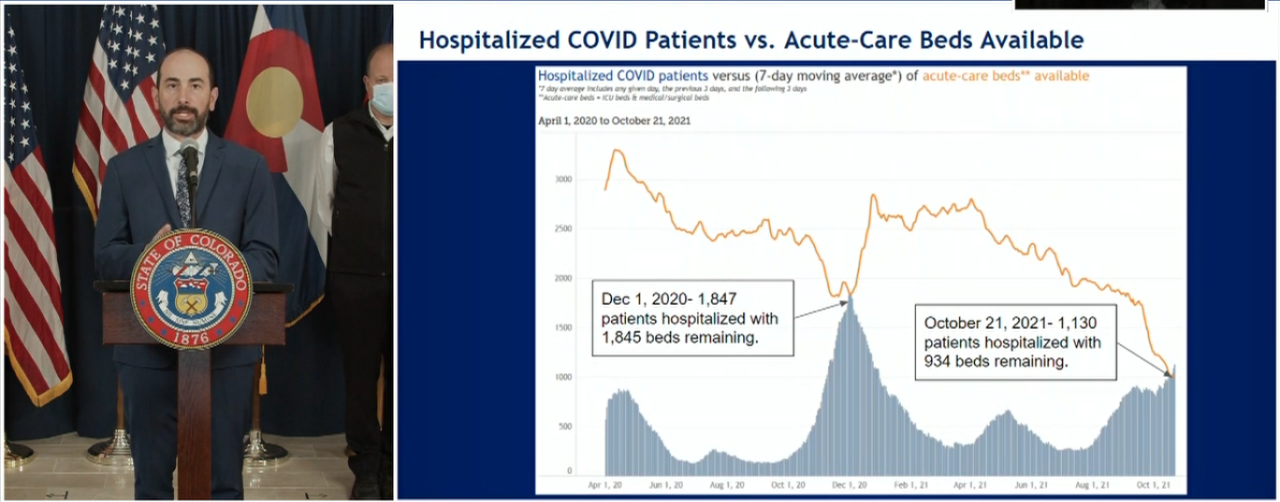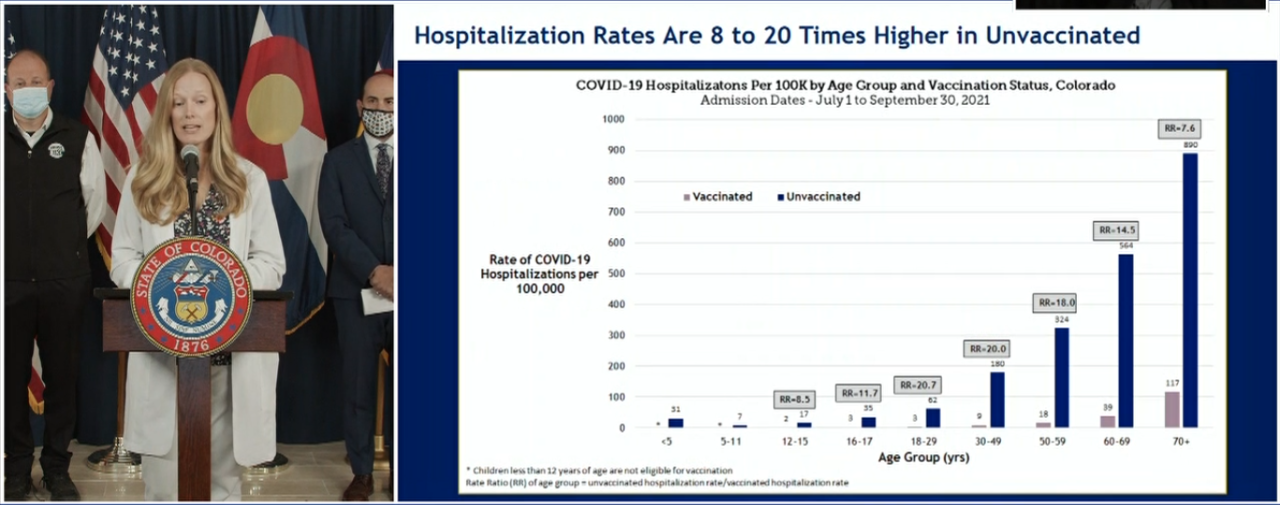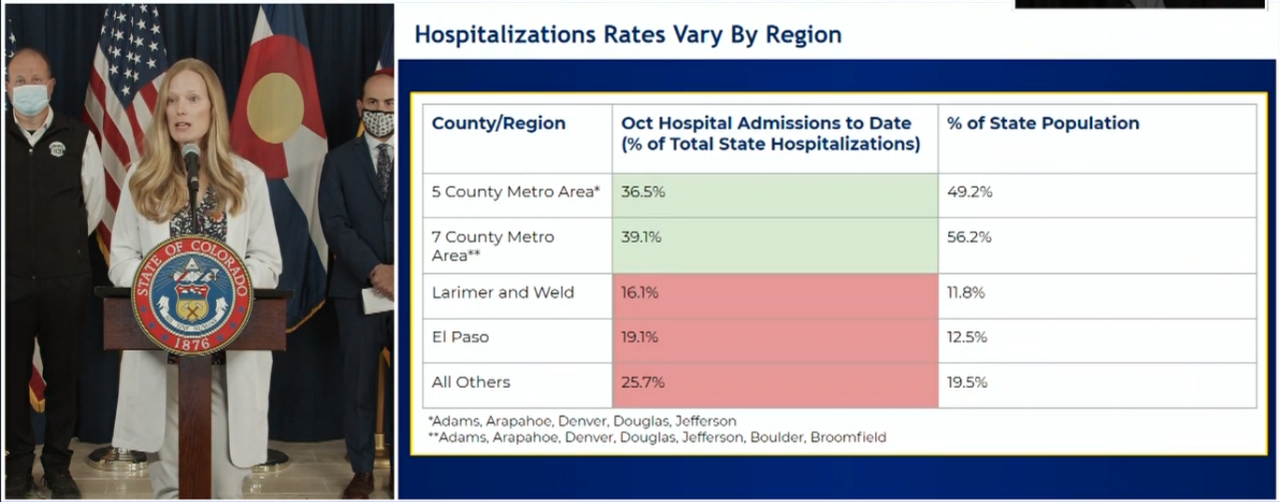DENVER – Nearly 90% of Colorado’s intensive care unit beds are currently in use – the highest share in at least 11 months – and Colorado officials continue to sound dire warnings about hospital bed capacity heading into flu season and the winter.
As of Thursday, 1,130 Coloradans were hospitalized with COVID-19 and 89.6% of the state’s ICU beds were being used by both COVID-19 and other patients, Gov. Jared Polis and the state’s top COVID-19 response officials said in a news conference Thursday.
Of those 1,130 people, 893 are not vaccinated and 237 are vaccinated, Polis said. The average age of a vaccinated person in the hospital is 73, while the average age of an unvaccinated person in a Colorado hospital is currently 57.
Scott Bookman, the Colorado Department of Public Health and Environment’s COVID-19 incident commander, said there were approximately 120 ICU beds available as of Thursday across Colorado. He said there were fewer acute-care beds available right now – 934 beds compared to 1,130 COVID patients hospitalized – than there were during last December’s wave when the state had expanded the number of those types of beds. On Dec. 1 last year, there were 1,847 hospitalized in acute-care beds and 1,845 remaining, according to data Bookman presented.

Bookman said the current trajectory of hospitalizations was making him more concerned about what could happen as more non-COVID patients require emergency care for things like brain and heart surgeries.
Dr. Rachel Herlihy, the CDPHE’s state epidemiologist, discussed data showing that while the U.S. hospitalization rates for COVID are falling as a whole, Colorado’s continue to increase.
She said the trends across the country and in Colorado have some variability, and could be based somewhat on seasonality, but that hospitalizations were up across all age groups, including a “rapid” increase in the age 70+ population group.
Hospitalization rates are between 8 and 20 times higher among unvaccinated people depending on age group, with the data showing younger Coloradans are more sufficiently protected in mid-October by the vaccines than the older populations, who generally got their vaccines earlier than younger groups and who may see some vaccine efficacy wearing off.

Those trends mean the roughly 28% of Coloradans who are not fully vaccinated – and 22% who have not received their second dose – should get the vaccine, the officials said.
They also urged people to get the booster shots if they are fully vaccinated, with the rollout of boosters Moderna and Johnson & Johnson vaccine recipients expected to come in the next week after CDC advisers recommended their use on Thursday afternoon for certain groups of people. The proposal will now go before the CDC director for final approval.
People who received the Pfizer vaccine regimen are already able to get a booster dose if they meet certain criteria and are six months out from their second dose.
“I love every Coloradan, but ultimately, you need to love yourself. You need to care about yourself,” Polis said. “…We want you to be healthy. Please get vaccinated. Get that booster dose.”
The governor highlighted data announced Thursday by Pfizer and BioNTech which showed that people who got the booster shot saw a 95.6% efficacy rate of protection against COVID-19. Polis said out of the 10,000 people, half of them did not receive the booster dose but had been fully vaccinated, and the other half received the third shot.
Out of the 5,000 who did get the booster, only five people got symptomatic COVID, Polis said. Among the group that did not receive the booster, 109 came down with symptomatic COVID. Polis said that “should be a clear message” as to the efficacy of both the initial doses of the vaccines and the booster shots.
The governor said the state now has a three-pronged focus moving forward in the pandemic – first, accelerating the number of people who are getting their initial doses; second, getting more widespread booster shots in arms; and third, successfully implementing the vaccination program for kids ages 5-17 once the vaccine is authorized by kids 5-11.
Colorado data continue to show that the counties with the highest vaccination rates are also seeing the lowest hospitalization rates, as evidenced by the numbers in Eagle, Broomfield, Boulder and Denver counties.

Herlihy showed another chart showing the seven Denver-metro-area counties, which make up 56% of the state’s population, account for 39% of Colorado hospitalizations. But Larimer and Weld counties, which account for about 12% of the state’s population, make up 16% of hospitalizations, and El Paso County accounts for 19% of hospitalizations despite being just 12.5% of the state’s population. Those latter counties have smaller shares of vaccinated people than other areas of the state.
“I will join the governor and Dr. Herlihy in urging all Coloradans who haven’t been vaccinated to get that shot and those who are eligible for boosters should get those as well,” Bookman said. “Those on the front lines deserve that.”
Polis again skirted a question about implementing more public health restrictions on a statewide basis, saying he appreciated the counties, like Boulder and Larimer, which had put in place mask requirements indoors, but he did not commit to anything broader beyond urging people to take the typical steps to avoid catching the virus.
But he did say that the state was ready to move back to its crisis standards of care, which were utilized when health care systems were overwhelmed by the virus earlier in the pandemic, and that plans were “ready to be implemented if needed” as they were last year.
The governor said he was meeting with hospital representatives Thursday afternoon, adding that the pandemic would “be over if we had everyone vaccinated.”




